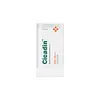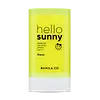What's inside
What's inside
 Key Ingredients
Key Ingredients

 Benefits
Benefits

 Concerns
Concerns

 Ingredients Side-by-side
Ingredients Side-by-side

Centella Asiatica Extract
CleansingDibutyl Adipate
EmollientPolyethylene
AbrasiveCoco-Caprylate/Caprate
EmollientDiethylamino Hydroxybenzoyl Hexyl Benzoate
UV FilterAcrylates Copolymer
Butylene Glycol
HumectantVinyl Dimethicone/Methicone Silsesquioxane Crosspolymer
Ethylhexyl Triazone
UV AbsorberOzokerite
Emulsion StabilisingNiacinamide
SmoothingVinyldimethicone
Dimethyl Malonate
PerfumingBis-Ethylhexyloxyphenol Methoxyphenyl Triazine
Skin ConditioningPolyglyceryl-4 Diisostearate/Polyhydroxystearate/Sebacate
EmulsifyingCentella Asiatica Root Extract
Skin ConditioningLavandula Angustifolia Oil
MaskingCitrus Aurantium Bergamia Fruit Oil
MaskingRosmarinus Officinalis Leaf Oil
MaskingChamomilla Recutita Oil
MaskingHydrogenated Lecithin
EmulsifyingOryza Sativa Bran Oil
EmollientSodium Chloride
MaskingGlyceryl Caprylate
EmollientCaprylyl Glycol
EmollientLauryl Polyglyceryl-3 Polydimethylsiloxyethyl Dimethicone
Skin ConditioningPolyglyceryl-5 Polyricinoleate
EmulsifyingEthylhexylglycerin
Skin ConditioningWater
Skin ConditioningAdenosine
Skin ConditioningTocopherol
AntioxidantGlycerin
HumectantTriethoxycaprylylsilane
Propanediol
SolventRaffinose
Skin ConditioningPentylene Glycol
Skin ConditioningPanthenol
Skin ConditioningCholesterol
EmollientCeramide NP
Skin ConditioningCalamine
AbsorbentTromethamine
BufferingChlorella Vulgaris Powder
Skin ConditioningMadecassoside
AntioxidantMadecassic Acid
Skin ConditioningAsiaticoside
AntioxidantAsiatic Acid
Skin ConditioningCalcium Aluminum Borosilicate
CI 77288
Cosmetic ColorantUltramarines
Linalool
PerfumingLimonene
PerfumingCentella Asiatica Extract, Dibutyl Adipate, Polyethylene, Coco-Caprylate/Caprate, Diethylamino Hydroxybenzoyl Hexyl Benzoate, Acrylates Copolymer, Butylene Glycol, Vinyl Dimethicone/Methicone Silsesquioxane Crosspolymer, Ethylhexyl Triazone, Ozokerite, Niacinamide, Vinyldimethicone, Dimethyl Malonate, Bis-Ethylhexyloxyphenol Methoxyphenyl Triazine, Polyglyceryl-4 Diisostearate/Polyhydroxystearate/Sebacate, Centella Asiatica Root Extract, Lavandula Angustifolia Oil, Citrus Aurantium Bergamia Fruit Oil, Rosmarinus Officinalis Leaf Oil, Chamomilla Recutita Oil, Hydrogenated Lecithin, Oryza Sativa Bran Oil, Sodium Chloride, Glyceryl Caprylate, Caprylyl Glycol, Lauryl Polyglyceryl-3 Polydimethylsiloxyethyl Dimethicone, Polyglyceryl-5 Polyricinoleate, Ethylhexylglycerin, Water, Adenosine, Tocopherol, Glycerin, Triethoxycaprylylsilane, Propanediol, Raffinose, Pentylene Glycol, Panthenol, Cholesterol, Ceramide NP, Calamine, Tromethamine, Chlorella Vulgaris Powder, Madecassoside, Madecassic Acid, Asiaticoside, Asiatic Acid, Calcium Aluminum Borosilicate, CI 77288, Ultramarines, Linalool, Limonene
Octyldodecanol
EmollientPropylheptyl Caprylate
EmollientOctocrylene
UV AbsorberButylene Glycol Dicaprylate/Dicaprate
EmollientEthylhexyl Methoxycinnamate
UV AbsorberDicaprylyl Carbonate
EmollientDibutyl Lauroyl Glutamide
Skin ConditioningEthylhexyl Salicylate
UV AbsorberDextrin Palmitate
EmulsifyingDibutyl Ethylhexanoyl Glutamide
Skin ConditioningDiethylamino Hydroxybenzoyl Hexyl Benzoate
UV FilterBis-Ethylhexyloxyphenol Methoxyphenyl Triazine
Skin ConditioningSilica Silylate
EmollientTocopheryl Acetate
AntioxidantBisabolol
MaskingCitrus Aurantium Dulcis Oil
MaskingLavandula Angustifolia Oil
MaskingCitrus Nobilis Peel Oil
MaskingDehydroacetic Acid
PreservativeEchium Plantagineum Seed Oil
Skin ConditioningLitsea Cubeba Fruit Oil
MaskingAnthemis Nobilis Flower Oil
MaskingHelianthus Annuus Seed Oil Unsaponifiables
EmollientCardiospermum Halicacabum Flower/Leaf/Vine Extract
Skin ConditioningTocopherol
AntioxidantWater
Skin ConditioningBetula Alba Juice
AstringentButylene Glycol
HumectantOenothera Biennis Flower Extract
Astringent1,2-Hexanediol
Skin ConditioningHypnea Musciformis Extract
Skin ProtectingUlva Lactuca Extract
Skin ConditioningEcklonia Cava Extract
Skin ConditioningCodium Tomentosum Extract
Skin ProtectingAgarum Cribrosum Extract
Skin ConditioningEnteromorpha Compressa Extract
Skin ProtectingLaminaria Japonica Extract
Skin ProtectingDunaliella Salina Extract
Skin ConditioningSargassum Fulvellum Extract
Skin ConditioningSargassum Muticum Extract
Skin ProtectingPorphyra Tenera Extract
Skin ConditioningSpirulina Platensis Extract
Skin ProtectingJania Rubens Extract
Skin ConditioningGelidium Cartilagineum Extract
Skin ProtectingEuglena Gracilis Extract
Skin ConditioningMacrocystis Pyrifera Extract
Skin ConditioningUndaria Pinnatifida Extract
Skin ConditioningCodium Fragile Extract
Skin ConditioningLaminaria Cloustoni Extract
Skin ProtectingCladosiphon Okamuranus Extract
Skin ConditioningChlorella Vulgaris Extract
Skin ConditioningSalicornia Herbacea Extract
Skin ConditioningPhenoxyethanol
PreservativePlankton Extract
Skin ConditioningPikea Robusta Extract
AntioxidantHydrolyzed Ulva Lactuca Extract
Skin ConditioningHaematococcus Pluvialis Extract
AntioxidantLaminaria Digitata Extract
Skin ProtectingDisodium EDTA
Ethylhexylglycerin
Skin ConditioningMacrocystis Pyrifera Protein
Skin ConditioningHydrolyzed Enteromorpha Compressa
Skin ConditioningOctyldodecanol, Propylheptyl Caprylate, Octocrylene, Butylene Glycol Dicaprylate/Dicaprate, Ethylhexyl Methoxycinnamate, Dicaprylyl Carbonate, Dibutyl Lauroyl Glutamide, Ethylhexyl Salicylate, Dextrin Palmitate, Dibutyl Ethylhexanoyl Glutamide, Diethylamino Hydroxybenzoyl Hexyl Benzoate, Bis-Ethylhexyloxyphenol Methoxyphenyl Triazine, Silica Silylate, Tocopheryl Acetate, Bisabolol, Citrus Aurantium Dulcis Oil, Lavandula Angustifolia Oil, Citrus Nobilis Peel Oil, Dehydroacetic Acid, Echium Plantagineum Seed Oil, Litsea Cubeba Fruit Oil, Anthemis Nobilis Flower Oil, Helianthus Annuus Seed Oil Unsaponifiables, Cardiospermum Halicacabum Flower/Leaf/Vine Extract, Tocopherol, Water, Betula Alba Juice, Butylene Glycol, Oenothera Biennis Flower Extract, 1,2-Hexanediol, Hypnea Musciformis Extract, Ulva Lactuca Extract, Ecklonia Cava Extract, Codium Tomentosum Extract, Agarum Cribrosum Extract, Enteromorpha Compressa Extract, Laminaria Japonica Extract, Dunaliella Salina Extract, Sargassum Fulvellum Extract, Sargassum Muticum Extract, Porphyra Tenera Extract, Spirulina Platensis Extract, Jania Rubens Extract, Gelidium Cartilagineum Extract, Euglena Gracilis Extract, Macrocystis Pyrifera Extract, Undaria Pinnatifida Extract, Codium Fragile Extract, Laminaria Cloustoni Extract, Cladosiphon Okamuranus Extract, Chlorella Vulgaris Extract, Salicornia Herbacea Extract, Phenoxyethanol, Plankton Extract, Pikea Robusta Extract, Hydrolyzed Ulva Lactuca Extract, Haematococcus Pluvialis Extract, Laminaria Digitata Extract, Disodium EDTA, Ethylhexylglycerin, Macrocystis Pyrifera Protein, Hydrolyzed Enteromorpha Compressa
Ingredients Explained
These ingredients are found in both products.
Ingredients higher up in an ingredient list are typically present in a larger amount.
You might know this ingredient as Tinosorb S or Bemotrizinol. It is a UV filter that covers both UVA and UVB rays.
This ingredient has two peak UV absorption peaks ( 310 and 340 nm) and is able to absorb both UV-A and UV-B rays. This ingredient works by preventing UV rays from reaching and damaging your skin.
On top of that - it is highly photostable and helps prevent the photodegration of other sunscreen ingredients such as avobenzone.
Tinosorb S is allowed in the EU, Australia, and Asia. It is close to being approved by the FDA and we'll hopefully get this ingredient in the U.S. by late 2025.
Fun fact: Tinosorb S is the most effective UV absorber at maximum concentration (measured by SPF) permitted in the EU.
This ingredient is oil-soluble, so your oil-cleansers will take this right off at night.
Learn more about Bis-Ethylhexyloxyphenol Methoxyphenyl TriazineButylene Glycol (or BG) is used within cosmetic products for a few different reasons:
Overall, Butylene Glycol is a safe and well-rounded ingredient that works well with other ingredients.
Though this ingredient works well with most skin types, some people with sensitive skin may experience a reaction such as allergic rashes, closed comedones, or itchiness.
Learn more about Butylene GlycolDiethylamino Hydroxybenzoyl Hexyl Benzoate (DHHB) is a chemical UV-A absorber. It is formulated for high UVA protection (320-400 nm).
DHHB is well-liked for:
DHHB has been approved by the EU, Japan, Taiwan, and South America for use up to 10%. Unfortunately, it has not been approved for use in the US or Canada due to slow regulatory processes.
This ingredient is soluble in oils, fats, and lipids.
Learn more about Diethylamino Hydroxybenzoyl Hexyl BenzoateEthylhexylglycerin (we can't pronounce this either) is commonly used as a preservative and skin softener. It is derived from glyceryl.
You might see Ethylhexylglycerin often paired with other preservatives such as phenoxyethanol. Ethylhexylglycerin has been found to increase the effectiveness of these other preservatives.
Lavandula Angustifolia Oil is more commonly known as lavender essential oil. It is considered a fragrancing ingredient.
Lavender imparts a famous scent. While the smell is lovely, this ingredient and may sensitize skin in topical products. This is because about 85% of the oil is made up of linalool and linalyl acetate.
When exposed to air, these two compounds become strong allergens. This ingredient exhibits cytotoxicity at low concentrations; amounts of 0.25% have been shown to damage skin cells.
A study from Japan found this ingredient caused lavender sensitivity after widespread exposure.
Lavender essential oil has some antimicrobial, antibacterial, and anti-inflammatory properties. However, the cons of this ingredient may outweight the pros.
More research is needed to confirm lavender essential oil's effects when used in aromatherapy.
Lavandula Angustifolia is known as the English Lavender and famous for creating purple fields in Provence, France.
Learn more about Lavandula Angustifolia OilTocopherol (also known as Vitamin E) is a common antioxidant used to help protect the skin from free-radicals and strengthen the skin barrier. It's also fat soluble - this means our skin is great at absorbing it.
Vitamin E also helps keep your natural skin lipids healthy. Your lipid skin barrier naturally consists of lipids, ceramides, and fatty acids. Vitamin E offers extra protection for your skin’s lipid barrier, keeping your skin healthy and nourished.
Another benefit is a bit of UV protection. Vitamin E helps reduce the damage caused by UVB rays. (It should not replace your sunscreen). Combining it with Vitamin C can decrease sunburned cells and hyperpigmentation after UV exposure.
You might have noticed Vitamin E + C often paired together. This is because it is great at stabilizing Vitamin C. Using the two together helps increase the effectiveness of both ingredients.
There are often claims that Vitamin E can reduce/prevent scarring, but these claims haven't been confirmed by scientific research.
Learn more about TocopherolWater. It's the most common cosmetic ingredient of all. You'll usually see it at the top of ingredient lists, meaning that it makes up the largest part of the product.
So why is it so popular? Water most often acts as a solvent - this means that it helps dissolve other ingredients into the formulation.
You'll also recognize water as that liquid we all need to stay alive. If you see this, drink a glass of water. Stay hydrated!
Learn more about Water